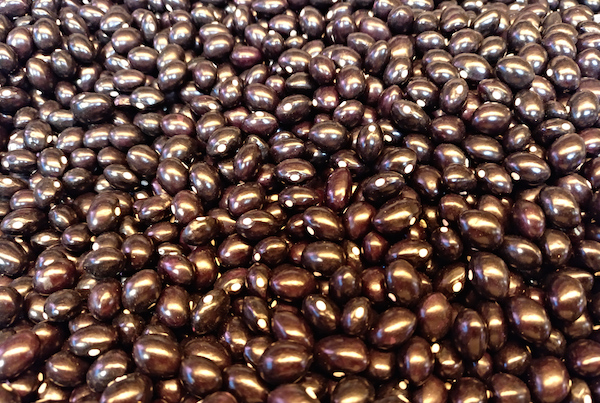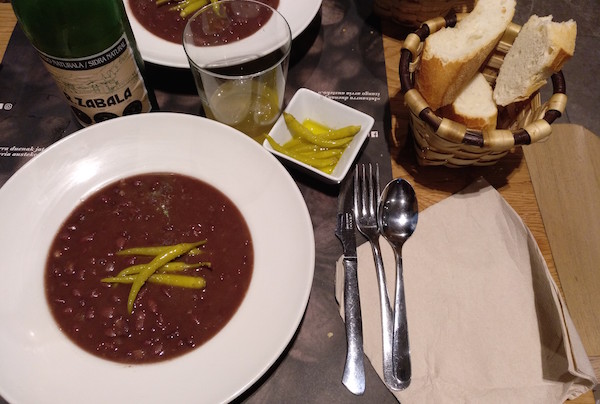This post is part of our Behind the Bite series: deep dives into the dishes that we can’t stop thinking about.
Believe it or not, there are over 40,000 varieties of beans in the world.
We have fava beans, kidney beans, navy beans, pinto beans, black-eyed peas, cannellini beans, lima beans, and finally: black beans from Tolosa.
Tolosa is a picturesque Basque village located about 30 minutes south of San Sebastian. It’s famous for its Saturday farmers market, carnival celebrations, beautiful setting in the Oria river valley, and their legendary black beans!
Basques take the bean business pretty seriously. Every November the world stops to celebrate babarrunaren astea (“week of the bean”). During the festival, Tolosa is inundated with this dark legume. Farmers compete to win the prize for the best bean produced that year. There is also an exhibition, a bean market, concerts and—of course—massive vats of bean stews.

A bit of history
Fun fact: these beans aren’t even native to Tolosa! They were brought from Venezuela two centuries ago, along with the traditional method of cultivating them in symbiosis with corn. Even the name has its problems, because alubias de Tolosa aren’t always even grown in Tolosa! They originally came from the surrounding farms and villages, but were sold at the market in Tolosa—hence the name. From there these black pearls travelled to France, Aragon, Castile and other capitals of the Cantabrian coast.
Compared to previous centuries, our bean consumption has declined significantly. In the past, they were an essential dish during the week for many people living in the countryside. Full of proteins and fiber, beans and chestnuts formed the basis of a farmer’s diet back in the day.
The arrival of the “welfare era” produced a change in eating habits. People who worked in the city no longer needed such a hearty meal and the consumption of beans reduced.

So what makes beans from Tolosa so exceptional?
First at all the tradition! “Una alubiada” (collective eating of beans usually during festivities) is an expression that brings to mind a good meal shared with friends or neighbors from your village. And it isn’t only about eating and sharing—we also have to talk about the tradition while experiencing it! About the alubiadas we’ve enjoyed in the past, and about the ones that will be eaten in other magnificent places in the future.
Black beans from Tolosa actually aren’t black. These famous legumes are really a beautiful burgundy color with a characteristic white dot in the middle. During the long simmering they experience during preparation, they change to an indefinite mixture of red and brown. Once ready, they’ll be swimming in a thick sauce that comes from starch released during the cooking process. However, what really stands out is their creamy texture and extremely buttery flavor!

No-frills approach
Those who have experienced Basque cuisine before understand that simplicity is the key to a successful dish. In this one, we don’t add spices, herbs, tomatoes or meat, and still the beans boast a robust and complex flavor. What’s the secret then? Well, it’s part of the cooking technique.
Roberto Ruiz Aginaga, a chef known in Spain as “the king of Tolosa beans,” says that the right heat, the moment when you add the salt (the end), and the “no stir” rule are crucial for creating a perfect plate of beans.
Apart from the beans, to complete this iconic Tolosan meal we have the option of serving them alongside a side dish of wilted cabbage, morcilla (black pudding), chorizo, or piparras (spicy, pickled green chillies typical of the region).

Time for the recipe!
Ingredients:
1 lb dry Tolosa black beans
2 liters cold water
olive oil
salt
Directions:
Place the beans in a large pot and rinse thoroughly. Add the cold water and a generous amount of olive oil, and place over high heat for the water to boil, then turn heat to medium-low. To see how the cooking is going, you can move the pot gently in a circular motion, but DO NOT STIR or the beans will break! You can slowly keep adding cold water if needed. After about two and a half hours the beans should be soft. This is the moment to season them with a pinch of salt and leave them to rest, so the stock thickens.
Where to eat Tolosa beans
Although it is an experience (and one that we highly recommend!) to visit the market in Tolosa during the fall and try the dish in its natural habitat, these lovely beans are served all over the Basque region. The easiest and cheapest way is to try them on a menú del día (fixed-price lunch menu) where the beans are served as one of the courses. You’ll see Tolosa beans on just about every restaurant table during the colder months starting in November.
These are great beans! Last fall we were in San Sebastian during a local products festival. We bought a big bag of the Tolosa beans. Probably the most beautiful beans I have ever seen. Cooked up well. Ate some whole as a side dish then put the rest in a blender to make a soup for another day. Another high quality product from the Basque region. Great article.
Yum!! Glad you agree, Heather!
Hello,
I want to go to Tolosa now I’ve read this! Do you know which weekend the festival will happen this year [2019]? Time to plan it now with our work rota.
kind regards,
Peter
So happy to hear that Peter! They won’t announce the date until later this fall. The festival depends on the harvest and the harvest could shift depending on what kind of a year we have in terms of rain. It falls sometime in the first half of November!
It’s a proper experience to buy them from the market, I usually buy from one of the older ladies, they grow them on their own little plots or on the railway embankment. If ever you have the chance buy some txacoli wine to go with them